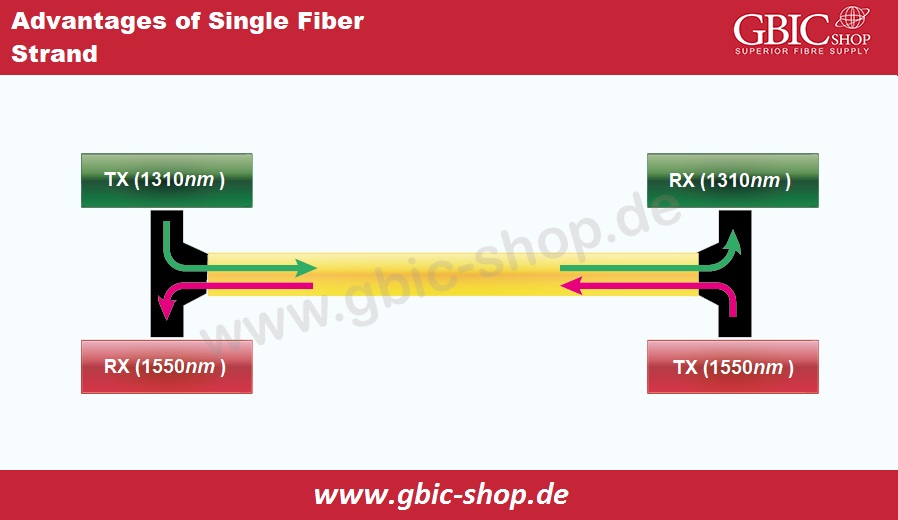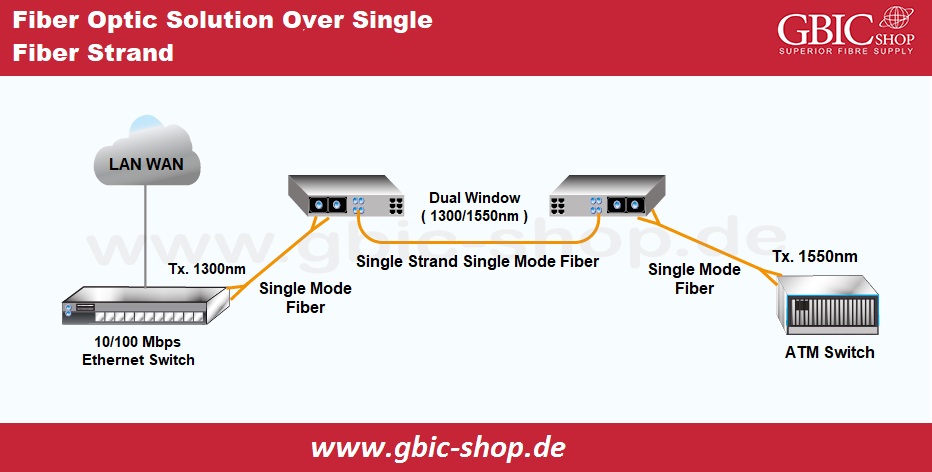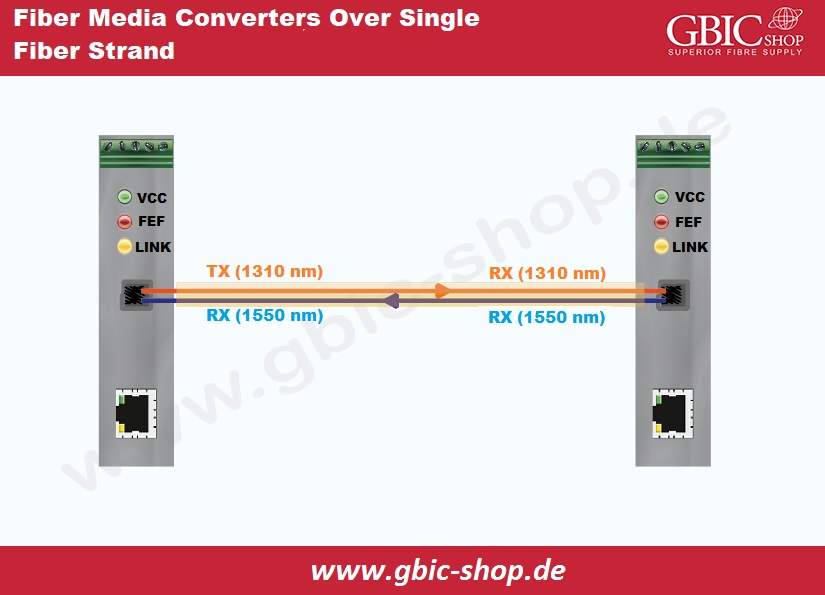In the past, complete two-way communication in fiber optic networking necessitated using two fiber strands. To attain complete duplex transmission, which allows for simultaneous transmission and reception of signals, we reserve one strand for transmission while the other is solely for reception. Recently, a novel fiber technology with a single strand that can transmit signals at two different wavelengths in opposing directions has surfaced. Thanks to this technology, many applications can now utilize single-mode mode fiber. As technology advances and bandwidth requirements escalate, the implementation of Gigabit Ethernet Circuits is on the rise, paving the way for the gradual emergence of 10Gbps single-strand circuits. The progress of Ethernet within IEEE initiatives promotes the adoption of solutions utilizing a single fiber.
We can make the fiber optimization easier with single fiber optic strand solutions. Rather than using two separate strands for transmitting and receiving, a single installed fiber optic plant can double capacity by carrying a Bi-directional signal. Doubling the per optical fiber ROI is possible with fiber plant capacity without requiring additional physical fiber. By increasing the capacity of fiber plants, it is possible to double the return on investment per fiber without requiring extra physical fiber.
Advantages of Using a Single Fiber Strand
Network capacity doubles instantly: By performing transmission and reception on one strand, a single fiber strand can enhance the fiber's capacity through simultaneous operation at multiple wavelengths.
Enhances Reliability: Reducing the amount of links or endpoints within a network can decrease potential issues. Customers can also utilize a solitary fiber to improve the network’s redundancy.
Cost reduction: Reducing the amount of fiber decreases maintenance and installation expenses, consequently lowering the total labor costs. By increasing the capacity of already existing fiber instead of installing more fiber, you can save on construction expenses.

Single Fiber Optic Strands Can Provide Optical Solutions
Single fiber optic strand MUX & OADM for CWDM/DWDM
GBIC-Shop accessory devices, including Bidi DWDM/CWDM products, have completed the 8/16/22 wavelength DWDM/CWDM MUX solution using a single fiber. This solution is compatible with 10 Gigabit and 10 Gigabit client interfaces. This solution utilizes a solitary mux with sixteen or eight channels, whether a DWDM MUX or CWDM MUX. Transmission and reception each have an equal allocation of half the MUX. The single fiber optic solution for forty-four wavelengths involved using a solitary fiber strand to transmit up to twenty-two client interfaces by assigning them to forty-four distinct wavelengths traveling simultaneously in the fiber's opposite direction.

GBIC-Shop has the solution of EDFA to overcome the high fiber optic budget required for transmission. It is common knowledge that conventional fiber optic data transmission requires a fiber coupler for data transmission and demands a higher cost and optical resources. However, GBIC-Shop offers a solution that utilizes DWDM and CWDM to transmit and receive data over a single fiber optic strand, minimizing investment and rental costs. The figure provides a comprehensive overview of the connection. The expansion of Metro Ethernet Networks has led to a broader selection of Metro WDM products, which now include CWDM/DWDM transceivers. Using a single-strand fiber allows the user to transmit and receive data simultaneously without needing an additional fiber cable, thus enabling entire duplex operation at a lower cost.
GBIC-Shop offers practical support for single fiber WDM in various topologies, including OADM, bus, ring, point-to-point, and more. To achieve RF wireless coverage with minimal fiber strands, GBIC-Shop utilized two 9/125 micrometer single-mode fibers, whereas other companies use four 9/125 micrometer single-mode fibers. It is common knowledge that the customer must lease fiber to access its strands. Therefore, achieving the objective of cutting fiber amount by half would be an appealing prospect for GBIC-Shop.
WDM technology provides the solution by ensuring that multiple wavelengths can travel through the same fiber strand without colliding with one another, and this is possible because the light sources do not interfere with each other, allowing for efficient transmission of optical signals through a single fiber strand. When paired with OADM technology, the remote repeater units and optical receiver unit channels enable exclusive filtering of dedicated wavelengths and other fiber optic wavelengths through system configuration, facilitating the use of a single fiber optic strand. Ensuring that a single fiber optic strand does not contain identical optical wavelengths is essential.
Transmitting SFP & SFP+ signals over a single fiber strand.
The Bi-Directional SFP/SFP+ transceiver offers a single-strand solution for long-range optical communication, ranging from 10 kilometers to 60 kilometers on single-mode fiber. It connects to downstream devices that comply with IEEE standards for BiDi communication, allowing for efficient upstream transmission. The SFP/SFP+ transceiver modules for BiDi function using one standard SMF strand. A 1000BASE-BX-D transceiver consistently connects with a transceiver 1000BASE-BX-U through this single strand. Refer to the accompanying diagram for further clarification. GBIC-Shop’s SFP and SFP+ with bi-directional capabilities offer increased bandwidth using fewer fiber strands. By utilizing our BiDi SFP/SFP+ transceiver, you can improve your capacity without the need for additional fiber installation, resulting in reduced costs for both cable installation and rental fees. Moreover, BiDi SFP and SFP+ support data rates and protocols:
The available network speeds are 125Mbps for Fast Ethernet, 155Mbps for SONET OC-3, 622Mbps for SONET OC-12, 1.25Gbps for Gigabit Ethernet, and 2.488Gbps for SONET OC-48. Both devices must transmit at different wavelengths to enable communication over a single fiber optic strand. The BiDi SFP and SFP+ will incorporate a WDM splitter to divide the 1310 nanometers and 1550 nanometers' light paths if one direction transmits a 1550 nanometer channel and the other receives a 1310 nanometer signal. Simultaneously, BiDi SFP adheres to industry standards by providing DOM functionality. However, opting out of this feature will result in reduced expenses.
At GBIC-Shop, various single fiber optic GBIC and SFP/SFP+ transceiver are available, along with single fiber optic passive options supporting multiple protocols or a single channel usage on a single fiber optic strand. These products enable DWDM and CWDM channel configurations, increasing bandwidth capabilities. Utilizing a single fiber optic transceiver can enhance the efficiency of your current or rented fiber infrastructure and provide greater adaptability in developing fiber installations. These transceivers can also serve as a foundation for future expansion, enabling the implementation of single-fiber Bi-directional and WDM deployments.
The reasons for implementing single-fiber transceivers may differ depending on the specific scenario. Still, adopting this approach has demonstrated its effectiveness in maintaining competitiveness and adaptability in creating and providing fiber-based data connections, mainly when fiber is scarce or expensive.
Single fiber strand for fiber media converters
The simplex media converter, or BiDi or single fiber optic media converter, enables customers to expand their Ethernet connections over a solitary multimode fiber connection. The conventional type of fiber optic media converters for multimode is “dual fiber” or "dual connector." Employing WDM technology is a viable option for existing fiber infrastructure to decrease expenses. WDM utilizes distinct receiving and transmitting frequencies to transmit a two-way signal over a solitary fiber strand. As a result, the fiber capacity doubles immediately without requiring additional cable deployment. Additionally, reducing the number of endpoint connections enhances reliability while reducing labor costs associated with installation and maintenance.

Utilizing a media converters' pair that transmits and receives data at varying wavelengths makes sharing data over a solitary fiber strand possible. According to the diagram, one converter sends signals at a wavelength of 1310nm, while the other unit sends at 1550nm. Hence, while picking a set of single fiber optic converter pairs, users should opt for one device that sends signals at 1310 nanometers and another device that sends signals at 1550 nanometers.
Summary
Entire duplex operation in fiber optic networks necessitates using a fiber pair. On the other hand, a single strand of fiber enables bi-directional transmission in full duplex mode, which is highly advantageous for those with restricted fiber management and financial resources.
 English
English
 Deutsch
Deutsch
 Espaniol
Espaniol










